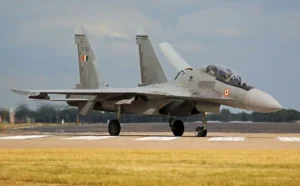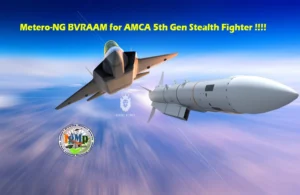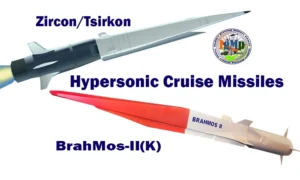 |
| Representative Image |
by Air Marshal PK Roy (Retd)
The current global security environment is becoming most unpredictable and volatile due to rapid technological advancement and the current geostrategic milieu, especially the Russia-Ukraine conflict. Development of advanced technology in weapon system is also creating a huge impact on modern war waging capabilities, especially in the aerospace domain. Air Chief Marshal VR Chaudhari, the Chief of the Air Staff said at a recent event “The ongoing Russia-Ukraine conflict is the first time we are witnessing the unfolding of ‘truly hybrid warfare’ and is a reflection of complete multi-domain operations that are taking place. We are witnessing the use of drones, hypersonic weapons, aircraft of all sizes and types and ground forces – all working in unison against the backdrop of economic sanctions and diplomatic heft.” It is therefore important for the IAF to accelerate its modernisation and become a modern, agile and technologically oriented air force.
Indigenising In Defence
The current Russia – Ukraine conflict is also putting Indian defence supplies under stress, reemphasising the importance of becoming self-reliant in defence with a steady supply chain unhindered by the happenings in the world. Towards this, Raksha Mantri Shri Rajnath Singh said at an event, “It is necessary that we not only create strong, modern and well-equipped forces, but also develop our defence industry, which is equally strong, capable, and completely ‘self-reliant’.” Indigenisation in defence therefore critical to national security.
Numbers Matter!
As the world’s fourth largest air force, IAF operates a mix of aircraft fleets largely of foreign origin, ranging from legacy MiG-21 Bison to Jaguar, Mirage-2000, MiG 29, Su-30MKI, TEJAS, and the Rafale aircraft. The current fighter squadron’s strength has reduced to 31 squadrons with the phasing out of one more MiG-21 Bison squadron this year. Squadrons planned to be phased out in the next decade and a half are three remaining MiG-21 Bison squadrons by 2025, followed by six squadrons of Jaguar by 2031-32 and thereafter the Mirage 2000s and the MiG 29s. Because of the slower rate of induction as replacement, the strength of IAF would remain well below its authorised strength of 42 squadrons for some time – 35 squadrons. As regards reviewing the authorised sanctioned strength of squadrons in the IAF, Air Chief Marshal Chaudhari in his press meet before the Air Force Day 2022 said “IAF was not looking at mere numbers but also at quality and technology. However, there are no plans to review the authorised sanction strength of 42 squadrons of fighters as the numbers are essential to operate in a large geographical area and conduct 24×7 air patrols.”
What is the present fighter strength of the IAF?
The IAF has an authorised strength of 42 fighter squadrons
As time passes, the drawdown is increasing as the total technical life is completed
However, the rate of new inductions is not matching the drawdown, depleting the overall number of fighter squadrons
Additionally, several frontline aircraft in the inventory including the Jaguars, and MIG-29s will begin phasing out by the end of the decade
For instance, by 2027-28 the first of the MIG-29s, inducted in the late 1980s, will start going out
Challenges
The visible depletion in operational air assets due to obsolescence and lack of new platforms
The decline in platforms is stark and from a strength of 42 combat squadrons in 2002, the IAF now operates barely 30
Even as there are plans to create new theatre commands and allocate existing air assets to the new formations, the depletion in numbers merits urgent review
Steps Taken
In the last few years, the IAF has inducted two squadrons of the indigenous Light Combat Aircraft (LCA) TEJAS and two squadrons of Rafale fighter jets procured from France which pushed the squadron strength to 32
In January 2021, the IAF had signed a contract with Hindustan Aeronautics Limited (HAL) for 83 of the more advanced TEJAS MK-1A which it will start receiving from early 2024 onwards
Along with that the to-be-acquired 114 Multi-Role Fighter Aircraft (MRFA) will help arrest the drawdown
A larger and even more capable TEJAS MK-2, as well as the fifth generation Advanced Medium Combat Aircraft (AMCA), are under development
IAF will start receiving the first of 83 TEJAS MK-1A, from 2023 onwards, with the last one to be received by 2028. Plans also exist for ordering TEJAS MK-2 and the indigenous 5th Generation fighter aircraft. Both these aircraft are still in the design phase. Further, the Services Qualitative Requirements of 114 Medium Role Fighter Aircraft is being formulated. The Request for Proposal would thereafter be issued. Considering the current enhanced threat perception from China and the perennial threat from Pakistan, there is an urgent need to induct five to six fighter squadrons to cater for the effects of shortfall in the strength of fighter squadrons. IAF has six IL-78 Flight Refuelling Aircraft (FRA) supporting our fighter fleet operating across the geographical spread of India. The FRA fleet along with the limited AWACS available, needs augmentation. IAF’s transport fleet is capable of providing full operational support to other two services.
Apart from the existing An 32, Avro and Dornier 228 transport aircraft, two major acquisitions have taken place in near past. First is the C-17 Globe Master III, a heavy transport aircraft with a capability to airlift over 70 tons of equipment. The other aircraft is the Special Operation aircraft C-130 J with a capability of lifting 20 tons of load. They proved their mettle by airlifting heavy tanks, APCs and air defence equipment etc when the Chinese tried to interfere with our LAC in the North. Ministry of Defence has approved procurement of Airbus C-295 as replacement of the aging Avro aircraft. 40 C-295s will be manufactured in India through a JV between Tata Advanced Systems Ltd and the Airbus Defence and Space.
IAF operates its helicopters in support of the Indian Armed Forces both, during war and peace as well as for the civilian requirements. It has a balanced mix of various types of helicopters that include the Mi-17; ALH ‘Dhruv’, Chinooks, Apache, Light Combat Helicopter (LCH), Mi-35 and the Chetak and Cheetah helicopters. Plans exist to phase out the Cheetah and Chetak helicopters by 2040 followed by the Mi 17s. Variants of ALH, Light Utility Helicopter and LCH would meet IAF’s helicopter requirements indigenously.
IAF has recently revised its doctrine based on the changing nature of warfare, rapid technological advancements, changes in threat perceptions and the experience gained in exercises with foreign air forces.
IAF has commenced cooperating with the private industry in developing unmanned systems. Results of ‘Mehar Baba Competition’ for developing drone swarm technology has been encouraging and IAF is in the process of placing orders. Plans are in place for induction of various types of systems ranging from small drones and counter drone systems to the MALE & HALE class of RPAs along with a weapon delivery capability.
IAF’s Air Defence network consisting of various upgraded surface-to-air missile systems, the indigenous Akash AD systems and the Russian S-400 systems is significant. IAF is in the process of inducting more similar systems and optimising the sensor utilisation in different domains like the space-based military, civil and commercial assets etc. IAF has been participating in various international exercises with an aim to expose its pilots to dissimilar aerial platforms and operation under electronic and cyber warfare conditions.
Some of the air forces with which IAF carries out exercises regularly are US Air Force, French Air and Space Force, Royal Australian Air Force, Republic of Singapore Air Force, Royal Air Force, United Arab Emirates Air Force, Israeli Air Force, Egyptian Air Force, Japanese Air Self Defence Force and many more air forces across the world. IAF aircrew have been rated as excellent professionals by them. IAF has recently revised its doctrine based on the changing nature of warfare, rapid technological advancements, changes in threat perceptions and the experience gained in exercises with foreign air forces.
Atmanirbharta Is Key To IAF’s Growth
As a rising economic power, India’s ability to equip its own military remains woeful. As per the Stockholm International Peace Research Institute, India was the world’s second-largest importer of major arms in 2014-18. Unfortunately, threats from two nuclear armed neighbours also did not galvanise it to prioritise this sector. However, in the present context, the ever-increasing need to modernise the Armed Forces and the Government-backed boost to the defence industry through Make-in-India initiative, provides an opportunity to the Indian DPSUs and private sector to tap the market and make India a leading defence industry.
Government is promoting indigenous design, development and production through various measures like regular updating the Defence Acquisition Procedure, rationalising various aspects of procurement, encouraging quicker decision-making, banning imports through issue of Negative Lists, permitting Foreign Direct Investment in defence production and organising Def-Expo. Big private industrial houses like TATAs, L&T, Reliance, Mahindras, Adani, Bharat Forge have come into defence manufacturing in a serious way. India aspires to become self-reliant in defence production and start exporting the indigenously produced systems through ‘Aatmanirbhar’ initiative. Reports indicate that to realise this dream, the budgetary requirements for IAF itself is about US $ 100 billion. Therefore, Government needs to increase the defence budget.







